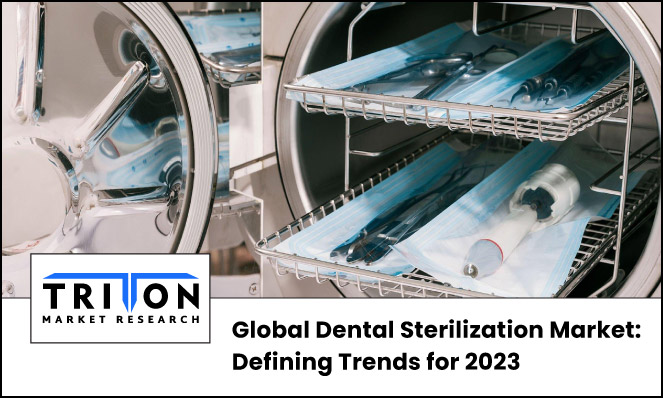



13, June 2023

Dental sterilization has surfaced as a vital sector, addressing the urgent need to maintain higher infection control standards globally. With the global dental sterilization market estimated to garner $1816.28 million by 2030, driven by factors such as the rising prevalence of dental diseases, cross-contamination risks, and cosmetic dentistry, it’s evident that the sector is at the forefront of promoting patient health. The market is projected to advance with a CAGR of 6.36% during the forecast period 2023-2030.
As per FDI World Dental Federation, oral diseases affect around 3.5 billion individuals globally. In this regard, approximately 2.3 billion people suffer from tooth decay. Moreover, periodontal disease affects up to 19% of the global population, leading to tooth fallout on numerous occasions. Given this rise in conditions, the number of dental procedures has soared, ultimately increasing the demand for sterilization instruments and consumables to eliminate the risk of cross-contamination.
While disease prevalence and cross-contamination are key aspects, the rise in cosmetic dentistry has further widened the application scope of sterilization equipment in dentistry.
Cosmetic dentistry services such as teeth whitening, dental bonding, tooth contouring, etc., have grown substantially over the past few years. This growing inclination is mainly attributed to rising consciousness about appearance and cost-effective procedures in developing nations. For instance, India, Thailand, and Malaysia have emerged as the three largest medical tourism destinations. In this regard, in 2022, the Indian government introduced the ‘Heal in India’ initiative to promote medical tourism. These factors thus further contribute to the Asia-Pacific dental sterilization market’s expansion.
Rising tourism for cosmetic dentistry has further boosted sterilization practices across hospitals, clinics, and dental laboratories. Triton’s analysis shows hospitals led the end-user segment, capturing revenue worth $611.80 million in 2022. Whereas the clinics category is estimated to witness the fastest growth at a CAGR of 6.49% during the 2023-2030 forecast period.
Furthermore, teeth whitening is among the widely opted treatments in aesthetic dentistry. Although cosmetic procedures are usually more voluntary than essential, several treatments offer restorative benefits, accelerating treatment demand. For example, dental veneers help resolve gaps, crooked teeth, and damaged enamel issues.
Accordingly, several health protection agencies, like CDC, recommend varying levels of disinfection and sterilization based on procedure and equipment type. Given these guidelines, players offer a varying range of dental sterilization instruments and consumables to lessen infection rates.
Medistel is one such instrument disinfectant consumable that is widely deployed for high-level disinfection of thermo-sensitive medical devices and surgical instruments. Based on product, the consumables category is projected to observe fast growth at a CAGR of 6.67% over the forecast period 2023-2030.
A medical device is a capital-intensive business that requires huge investments to manufacture innovative products. For example, Dentsply Sirona expends around $125 million yearly in dentistry research and development. Several establishments have thus commenced adopting innovative strategies to gain a competitive edge. Some of the prominent strategies include:
In March 2023, Getinge acquired Ultra Clean Systems Inc, a leading US manufacturer of ultrasonic cleaning technologies.
In January 2023, Steelco Group unveiled the New DS 610 G2 Series, a sterilizer with 12-DIN-tray capacity. It limits water and energy consumption to deliver high process efficiency.
Applied Medical Europe collaborated with Getinge in November 2022 to deploy Getinge’s GEE Ethylene Oxide Sterilization System for its new facility in the Netherlands.
In 2022, De Lama Launched HyPerPure® Low-Temperature Sterilization equipment that enables greater efficiency at a reduced cost.
Orotol Plus was launched by Dürr Dental in 2021 that is used for simultaneous disinfection and care of dental suction systems, amalgam separators, and spittoons.
Over the years, the dental industry has expanded substantially owing to awareness of several oral ailments. This has prompted various advancements in dental technologies to offer contemporary and precise solutions. On this front, digital X-rays using sensors eliminate over-exposure to radiation. Moreover, FDA-approved ultraviolet, handheld devices enable dentists to detect oral cancer at the initial phase. Further, deploying various non-invasive and laser systems has reduced reliance on numbing injections or pastes.
However, the employment of advanced equipment requires efficient and thorough disinfection procedures, accelerating the demand for cutting-edge sterilization equipment. Such tech-induced developments are expected to influence market contenders to expand their portfolio, which will open new avenues for the dental sterilization market.
Hospitals, clinics, and dental laboratories are key end-users in the dental sterilization market, with hospitals capturing the highest market share.
Q2) What is the market size of dental sterilization?The global dental sterilization market garnered $1102.47 million in 2022 and is estimated to reap around $1816.28 million by 2030.

Prevalent cases of terrorist attacks in today’s world is increasing the need for severe standards of security for public safety, and the global market for biometric technology scrupulously accommoda..
Prevalent cases of terrorist attacks in today’s world is increasing the need for..